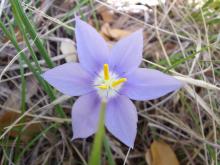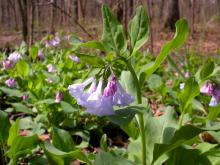Wildflowers, Grasses and Other Nonwoody Plants
Media

Species Types
Scientific Name
Conoclinium coelestinum (formerly Eupatorium coelestinum)
Description
Mist flower, or wild ageratum, is a vigorous native perennial bearing fluffy-looking, bluish-purple flowerheads. It looks quite a bit like the annual ageratum that is sold as a bedding plant in garden centers.
Media

Species Types
Scientific Name
Nemastylis geminiflora
Description
Celestial lily, in the iris family, blooms only in the morning. Its showy, lavender-blue flowers shine like six-pointed stars on glades and prairies in southern Missouri and the eastern Ozarks.
Media

Species Types
Scientific Name
Geranium maculatum
Description
Called “crane’s bill” for its sharply pointed seed capsules, wild geranium is a gardening favorite, and there are cultivated varieties of this woodland wildflower bred for unique petal and leaf colors.
Media

Species Types
Scientific Name
Hydrophyllum appendiculatum
Description
Woollen breeches bears clusters of light blue, bell-shaped flowers. The lower leaves of this hairy plant are shaped something like maple leaves and often have grayish or light green marks that look like water stains.
Media

Species Types
Scientific Name
Ruellia strepens
Description
Although the funnel-shaped, 5-lobed flowers look something like the petunias you find at garden centers, our wild petunia is not related to them. This ruellia often has crinkled hairs in 2 narrow, lengthwise bands on opposite sides of the stalk.
Media

Species Types
Scientific Name
Perilla frutescens
Description
Introduced as an ornamental, beefsteak plant is native to Asia. It is common in moist or dry wooded bottomlands, open valley pastures, and along trails, railroads, and roadsides. It spreads invasively in our state.
Media

Species Types
Scientific Name
Mertensia virginica
Description
One of our most stunning early spring wildflowers, bluebells is also a popular native plant for gardening. As with all native plant gardening, make sure you get your plants from ethical sources.
Media

Species Types
Scientific Name
Carduus nutans
Description
An invasive native of Eurasia that is spreading in Missouri, musk thistle is a plant you should know. Learn how to tell the difference between our native thistles and these bad guys.
Media

Species Types
Scientific Name
Cirsium vulgare
Description
Bull thistle is a weedy introduction from Europe, found statewide. To tell it from our other thistles, note its stems with spiny-margined wings, and its leaves with the upper surface strongly roughened with stiff, spiny bristles.
Media

Species Types
Scientific Name
Cirsium altissimum
Description
Tall thistle is a native thistle that can grow to be 10 feet tall! To identify it, notice its leaves, which are unlobed (though they may be wavy or have only shallow, broad lobes), are felty-hairy beneath, and have prickles only along the edges.
See Also
About Wildflowers, Grasses and Other Nonwoody Plants in Missouri
A very simple way of thinking about the green world is to divide the vascular plants into two groups: woody and nonwoody (or herbaceous). But this is an artificial division; many plant families include some species that are woody and some that are not. The diversity of nonwoody vascular plants is staggering! Think of all the ferns, grasses, sedges, lilies, peas, sunflowers, nightshades, milkweeds, mustards, mints, and mallows — weeds and wildflowers — and many more!





















